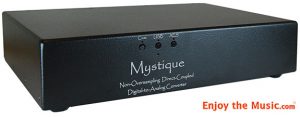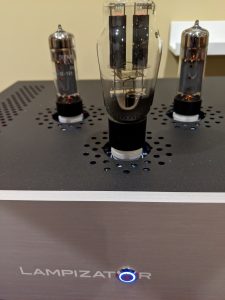Cutting edge technologies are expensive. Whether they are used in medical, food, or military industry, or for sound recording and playback. Small companies deal with this issue using solutions developed by major players, multinational corporations that sell licenses for their products. What they have to do is to tweak such product/solution, customize it for their own purpose. That's how most audio companies work.
So usually the first products such small manufacturers release are rather expensive, I mean - high end expensive. Only after such company "recovers" from high initial costs/expenses (and these are huge just as the risk such entrepreneur takes) then the solutions, high-tech, might be also applied in less expensive products. Surely release of less expensive products is possible only when some savings are made (to cut the costs of production), but advantages of such solution/technology offer considerable advantages.
In this particular case, of British company Chord, the story is a bit different. It is an autonomous manufacturer that from the very beginning invested a lot in their R&D department thus creating a large pool of knowledge, solutions and experience. So it is able to use some general ideas taken from the market but put them to their own use and use their own pricing. John Atkinson, Chief Editor of Stereophile magazine described it in his DAC64 review as following:
…What has happened is that the cost of owning a state-of-the-art CD-playback component has dropped significantly, compared with only a few years back. So when British amplifier manufacturer Chord Electronics showed its first D/A processor at the 2001 Consumer Electronics Show, I was not too surprised that this statement product was intended to sell not for $20,000 or $10,000 or $5000, but for $3040".
John Atkinson, Chord Electronics DAC64 D/A processor, Stereophile 2002, see HERE
This short sentence explains very well what Chord is and what it is not—it offers relatively expensive devices, also digital ones, they were created in a process of development of some inexpensive solutions available on the market.
DAC64, that Atkinson described, became for Chord their flywheel that changed company's history. Basing on this product they developed few complete product lines with a very characteristic design, and the key solution used in this DAC—digital filter called Watts Transient Aligned (WTA) became a very basic solution used by Chord in every D/A converter. The latest DAC called Dave (more about its premiere HERE) is sort of the apex of company's efforts.
A story of a DAC/headphone amplifier Hugo seems similar. Many of you most likely saw a short clip showing a tank running over Hugo (HERE). After that Hugo is perfectly fine, no scratch on it. The idea was to make an almost indestructible mobile device. As on option one might also buy a wonderful leather cover for it. Then all one has to do is to deliver a signal to Hugo (from a laptop or smartphone for example) and voila—a mobile high-end system is there to offer fantastic performance.
Hugo TT premiered this year and it is a new, more advanced version of basic Hugo. TT might be explained as Top Table—as new Hugo is more of a stationary device. But still battery powered and in this indestructible aluminum enclosure.
Hugo TT is a D/A converter and a headphone amplifier in one body. It sports four digital inputs, two pairs of analogue outputs and three headphone outputs. It sports also a digital volume control which allows user to connect it directly to a power amplifier—the output signal is significantly higher than standard (for a CD Player) 2V, but I haven't found any specific information about exact value.
There are two asynchronous USB inputs: one for 16/44,16-48 signals—it does not required any additional driver, and a second one for hi-res PCM signal up to 32/384 and DSD128 (driver required). An interesting solution is a BNC input that also accepts same hi-res signal as USB. That is something new as up to now DXD and DSD signal was almost exclusively accepted only by USB inputs of different DACs. There is also a Toslink input that accepts signal up to 24-bit/192kHz.
Unit sports a small dot-matrix display on the front but it delivers only information about active input, about whether user increases or decreases volume and whether or not user activated Crossfeed. Most information for user is in fact coded using colors. One has to learn the code but it should not be a problem. Sampling frequency and volume are indicated by a large light placed in the middle of the top cover. Depleted battery, active input and Crossfeed mode are indicated by small LEDs that can be seen via a lens placed next to it.
At first one sees no buttons, no knobs on Hugo TT that would allow user to change volume. Volume control is conducted via "G" point—a backlit knob that delivers different information and that might be turned right or left. That's a really cool solution but what I missed for an alphanumeric information about volume level. I also found using a remote control for volume control bit problematic.
DAC is a balanced design and thus it sports both, balanced and unbalanced outputs on the rear panel. There are three headphone outputs but none of them is balanced. I think that a headphone amplifier at this price and performance level should include also a balanced output. But to be fair I have to notice here, that my Bakoon HPA-21 also sports and an unbalanced output. The device sports a flat chassis, its fit&finish is fantastic and its functionality impressive. But the ergonomic is not as good as other features.
SOUND
Recordings used for this test (a selection):
- Billie Holiday, Jazz at the Philharmonic, Clef Records/UMG Recordings UCCV-9476, „David Stone Martin 10 inch Collector’s Selection", SHM-CD (1945 | 1946/2013).
- Deep Purple, Now What?!, Edel Germany/Victor Entertainment VIZP-116, 2 x SHM-CD (2013).
- Depeche Mode, Black Celebration, Mute/Sony Music Labels SICP30539, Blu-spec CD2, (1986/2014).
- Depeche Mode, Ultra, Mute/Sony Music Labels SICP-30543, Blu-spec CD2, (2007/2014).
- George Michael, Faith: Special Edition, Epic/Sony Music753202, 2 x CD + DVD (1987/2010).
- Grateful Dead, The Best of Grateful Dead, Rhino 2795598, 2 x HDCD (2015).
- Handel, La Maga Abbandonata, Simone Kermes, Maite Baumont, Il Complesso Barocco, conducted by Alan Curtis, Deutsche Harmonia Mundi/Sony Music Entertainment, CD 88697846212, CD (2003/2011).
- Hilary Hahn, Hilary Hahn Plays Bach, Sony Classical, SK 62793, "Super Bit Mapping", 2 x CD (1997).
- Hilary Hahn, Hilary Hahn Plays Bach, Sony Classical/Sony Music Japan Entertainment, SICC 30087, "Best Classics 100", Blu-spec2 CD (1997/2012).
- Hilary Hahn, Bach • Concertos, conducted by Jeffrey Kahane, Los Angeles Chamber Orchestra, Deutsche Grammophon/Universal Music LLC [Japan] UCCG-50058, SHM-CD (2003/2011).
- Perry Como, Perry ComoBMG Ricordi SPA 993320, 2 x CD (2000).
- Radiohead, In Rainbows, XL Records XLCD 324, CD (2007).
- Rival Sons, Great Western Valkyrie, Erache Records/Hydrant Music QIHC-10059, CD (2014).
- Robert Schumann, Violin Concerto, Isabelle Faust, Harmonia Mundi HMC 902196, CD + DVD (2015).
- Tori Amos, Little Earthquakes, Atlantic/Rhino 2795617, 2 x CD (1992/2015).
- Tori Amos, Little Earthquakes, EastWest 82358-2, CD (1992).
- Wes Montgomery, Incredible Jazz Guitar of Wes Montgomery, Riverside/JVC VICJ-41531, K2 CD (1960/2006).
For years digital sound was for the turntable users a symbol of poor performance, regardless of the price one had to pay for a CD Player or DAC. And to be fair, they were mostly right. CD Players and later D/A Converters offered bright, dry, "mechanical" sound. Despite the fact that dynamic range of a Compact Disc was in theory bigger than vinyl's, this digital sound sounded compressed, sucked dry of all vitality. The best, hence most expensive, devices did some things well and offered in result quite nice performance. But these cost a fortune.
A breakthrough was achieved when designers realized how destructive to the sound was this little, often even overlooked factor, called jitter. In short jitter is a deviation from true periodicity of a presumed periodic signal. And while even some digital product today still haven't mastered this issue, in general progress in this area that has been made in recent years is amazing. All it took was to use high quality master clocks, take care about proper power supply for all modules, take care of vibrations and voilà!
When finally they managed to reduce jitter to a level when it stopped to play the main "bad guy" in digital signal, other flaws came to surface, previously unrecognized because of jitter, like improper digital filters for example. This issue was actually known before but nobody seemed to take it seriously. Classic filters with greatly accelerated roll-off slopes cut off all frequencies outside audible range which in fact significantly changed also the audible part. After converter received impulse signal it gave back not only the particular impulse but also pre- and post-ringing. Long story short—the effects of ringing were finally limited due to apodizing filters. Such filters were almost perfectly utilized by companies like Ayre and Meridian. Some other companies decided not to use any filters at all—for good and for bad (more HERE).
That's when we get to the clue of this test: with good engineering that is based on both, knowledge and practice/experience it is possible today to create a relatively inexpensive digital device that will easily win any head-to-head against top Players from 15-20 years ago. Hugo TT is a perfect example. It is very difficult for me to write but... I have to man up and clearly state that this British D/A Converter outperforms in some areas my beloved Ancient Audio Lektor AIR V-edition. And considering all aspects of sound it comes really, really close to my CD Player (with a signal delivered from Lektor's CD transport).
The key element of Chord's performance is how amazingly resolving it is. This feature translates in this case not into more detailed presentation (at least not most of all) but to a more musical one. It is obvious that the more resolving the device is the more details it delivers. But only deeper in the recording as these create some additional value that allows us to experience the music in a deeper, more intense way.
It was also obvious to me, that Chord delivered very open sound throughout the whole range. It was very easy to notice in treble area, but it was actually most impressive in bass area. It was here, in the lowest region, that Chord achieved the biggest improvement. This is the real BASS, that before I heard in my room only when using Accuphase DP-901 and Harmonix DAP-999EX Limited - both devices were much, much more expensive. Chord delivers powerful, "meaty" nicely differentiated bass—there are plenty of tonal and dynamic shades. Depeche Mode albums breathed rhythmically with Chord, and older, mono recordings due to this powerful bass base sounded richer, with denser, "bigger" midrange. At the same time bass never sounded overblown, I never thought there was too much bass presence.
So bass, or in general the lower part of the range RULES! And so does the soundstage. We'll get there in a moment but I want to point it out already that treble also seemed quit powerful on both, linear and headphone outputs. These two elements differ but at the same time complement each other really well. If you want a better headphone amp you need to think about some expensive stand-alone device like Bakoon HPA-21 for example. DAC on the other hand can easily work in really expensive, much more expensive than DAC itself, systems.
Anyway—treble seemed open, clear, powerful and distinct. That reminded me of older top devices like, for example, Accuphase DAC DP-91 from early 1990ties. But only with such refined digital filters and advanced power supply now we get something that back in the day was delivered only by DAC chips without any filters, like TDA1541, without its flaws: sweetness, richness and proper weight.
I was curious how would such lean sounding device handle not so perfect recordings that have problems with treble clarity, like most rock albums. And it sounded fantastic. Yes, I could clearly hear some resonance in Tori Amos's voice but I perceived it rather as a flavor of this recording not its essence. I had similar impressions when listening to Deep Purple's Now What?!, Maroon5's V and many others. Each time sound was incredibly dynamic, clean, transparent but also rich and full.
There is also another thing apart from a bass that Chord outperformed my Lektor with. Although it seemed impossible for me, British DAC delivered a better organized sound panorama. Yes, I mean panorama and not soundstage because it's about both—acoustic environment and phantom images. The latter delivered by Polish Player, and also by top Accuphase system with DP-901 DAC receiving signal from CEC TL0 3.0 transport, were even better—smoother, richer, more distinct. But at the same time my Player placed all phantom images closer together, leaving them less space to breathe.
Density of Hugo TT's sound is surely better than average. So is its dynamics—it seems to come directly from the clarity and resolution of the sound. What Ancient Audio Player does in a better way, as do the two above mentioned systems, and surely also full Vivaldi dCS system, is imaging. Imaging might not be the most important feature of the sound for most music fans but the more experience they gain, the more sophisticated system they have the more important imaging becomes right up to the point where it becomes a key feature—if it's not good enough, particular component or system is also no good anymore.
Hugo TT perfectly differentiates fullness, depth and tangibility of phantom images (I mean both—instruments and voices). Mostly due to amazing holography of the presentation. But it still can be done in a better, more sophisticated way but than one has to pay for it few times more, like for AIR V-edition for example. It will pay more even fuller, richer images of each sound source which will make them even more natural.
Headphones
I am separating description of Hugo TT as a headphone amplifier just to make thing easier for readers. Chord's DAC was intended as a development of the Hugo, which is equally D/A Converter as it is a headphone amp—they are supposed to work together. In this case, of TT version, it's a bit different story as the linear outputs allowing using it in the "big" stereo system with loudspeakers, are also equally important feature. And yet it is still an integrated solution.
I compared the headphone amp section to, also battery powered, stand-alone headphone amplifier Bakoon HPA-21, that cost as much as Hugo TT—the two-in-one device. Signal to Hugo was delivered via digital cable from Lektor AIR V-edition's Philips CD Pro2 LF transport and from my laptop, and then I connected Hugo via linear output with Bakoon using Siltech Triple Crown interconnect. This way I used Hugo's DAC section in both cases and could compare only headphone amplifiers.
It turned out the Hugo TT was also a very good head amp, although this section was not as versatile as its D/A Converter. I definitely preferred it paired with Audeze LCD-3 and Sennheiser HD-800 than with my reference HiFiMAN HE-6. Sound with the latter pair of cans was too light and too bright. Chord itself did not add any brightness to the presentation which was clear when I listened to HD-800, that had tonal balance set bit higher then Audeze, but not because amplifier made them sound brighter but because that was their sonic character; Audeze offered amazingly creamy, rich sound, although their tonality was also "set" by their designers (that Is why some reviewers prefer LCD-XC over LCD-3).
With these two models of headphones Hugo TT delivered a beautiful sound—rich, dense, with nice bass extension and great dynamics. Sound was not as resolving and as selective as from linear outputs of the device, and so wasn't the dynamics. And yet it was still good enough for me to fully enjoy powerful music of Deep Purple as well as a refined performance of Charlie Parker.
And just shortly about „Crossfeed". It expands the sonic bubble inside our head but it has consequences—sound isn't so palpable, nor so dense as it is without Crossfeed. Powerful rock suffers most as the dynamics is lowered. Positioning of each element on the soundstage is less precise too which is especially obvious when listening to binaural recordings that already are particularly rich with spacial effects. Using this filter will be user-dependent, for me it was almost completely useless. Almost, because there was one exception—mono recordings that were converted into stereo ones. You'd be surprised to find out how many of those are there on the market. For such recordings I used a maximum setting of this filter to achieve undoubtedly better sound than without it.
Summary
The digital technology finally matured. High quality turntable still offers something that no digital device can, but, in my opinion, it is no longer a decisive factor. DAC Hugo TT sounds so well, in such a refined way, that one tends to simply enjoy the music without looking into what makes this device sound so great.
DAC section of this device is simply remarkable, headphone amplifier might not be that great but it is still very good. One should partner Audeze or Sennheiser cans with it and will be very, very happy about this combination. It is one of very few DACs at this price level that so clearly show differences between different sampling frequencies and between PCM and DSD signal—most DAC are simply not resolving enough to do that. RED Fingerprint award.
DESIGN
Hugo TT is built like a tank, just like original Hugo is, so these clips with some heavy tanks running over these devices seem quite adequate. Chassis is made of very thick, rigid aluminum elements. Top cover seems particularly interesting as it includes few particular elements like a backlit (in different colors) volume knob. Color of the light changes depending on volume setting.
Colors are also used to code other information for user. Under a convex lens one can see fragment of a PCB with three multi-color LEDs. These deliver information either on the battery life, or active output and a level of Crossfeed mode. One has to learn to read these information or one won't have a clue. A green dot-matrix display delivers information on active input, and level of spacial effect (Crossfeed) used for headphone output. After a while of user not applying any changes display goes dim. Small buttons placed beneath this display allow user to control this Crossfeed modes and select required input. On the right-hand side there are three headphone outputs—one 3.5 mm and two 6.35 mm. All of them unbalanced.
Hugo TT sports both types of analogue outputs—balanced (XLR) and unbalanced (RCA). It sports also four digital inputs: BNC and TOSLINK (both S/PDIF) and two USBs—one SD USB and the other HD USB. BNC accepts PCM signal up to 32-bit/384 kHz and up to DSD128, TOSLINK PCM up to 24-bit/192 kHz, USB SD 16/44,1 (or 48 kHz), and USB HD PCM up to 32-bit/384 kHz and DSD up to DSD128 (Double DSD). These are asynchronous USB inputs with full galvanic isolation. Rear panel holds also a power inlet that allows user to connect it to the external power supply.
This external power supply of Hugo TT does not supply the device directly but in fact charges batteries. There are four of them supported by two large capacitors, 5 farads each (!). Just few years ago such huge capacitance, even for 5V voltage, were difficult to imagine. In Hugo TT these serve as a sort of turbo-charge, extending the battery life as well as improving dynamics and demanding transients in recorded music.
Lets have a look inside—apart from already described power supply section we shall find there a main PCB, that seems to be identical with the one from Hugo, and another large PCB with smaller one soldered to it. The bigger one includes headphone outputs and analogue output stage based on NE5534 chips.
Signal from USB input goes to Texas Instruments PCM 2706 chip. Signal is decoded in a large, fast FPGA Spartan 6—it includes digital filters and D/A converter, Chord's patented solution called Pulse Array. At the side there is a raw of bipolar output transformers. Signal from USB inputs is delivered via short USB/micro-USB cables. There is also z Bluetooth receiver module—Hugo TT is capable of decoding aptX signal.
DAC sports a system remote control that will work also with company's CD Player, and streamer. Remote control sports a very nice, aluminum body. This improved aesthetics significantly although not necessarily the ergonomic as the push buttons sits bit too deep so it's not easy to actually push them.
Specification (according to manufacturer)
THD: - 140 dB
Headphone output: 110 dB SPL/300 Ω
Inputs:
- 1x TOSLink 24 bit/192 kHz
- 1x BNC 32 bit/384 kHz
- 1x HD/SD USB B-type 32 bit/384 kHz | DSD128
Outputs:
- 1x 3,5 mm mini-jack
- 2x 6,35 mm large jack
- RCA
- XLR
Dimensions: 235 x 45 x 225 (WxDxH)
Weight: 3 kg
Price at the time of the test: 2995 GBP
CHORD ELECTRONICS Ltd.
The Pumphouse | Farleigh Bridge
Farleigh Lane | East Farleigh
Kent | ME16 9NB
MADE IN ENGLAND
Text: Wojciech Pacuła
Images: Wojciech Pacuła | Chord (no. 1)














































